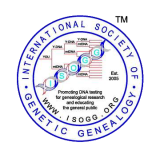Visual Phasing Reveal Widget (Borland Genetics)
From ISOGG Wiki
The Visual Phasing Reveal Widget, displayed on the project screen upon completing a visual phasing project, offers an interactive visualization of the user's visual phasing results. Users have the ability to select specific sibling pairs and chromosomes for in-depth comparisons. Upon selecting a sibling pair and a chromosome from the drop-down menus, the displayed visual phasing results dynamically update, allowing for immediate inspection and comparison of the DNA segments of the chosen sibling pair on the specified chromosome.
Within the Visual Phasing Reveal Widget, the visual phasing results are organized as:
1. Chromosome Title: At the outset, a title is displayed, indicating the chromosome number being viewed, such as "Results-Chromosome 1."
2. Graphical Representation: Just below the title, a graphical display visually represents the various DNA segments and their phasing results:
- Segments are distinctly color-coded based on their association with specific grandparents, like the paternal grandfather or maternal grandmother. *The visualization is split into two primary rows, each representing one of the two siblings being compared, providing clarity on the DNA segments each sibling has inherited from their grandparents.
3. Tabular Representation: Further below the graphical display, a structured table provides a textual representation of the visual phasing results:
- Region Number: Sequential numbering of the DNA regions on the chosen chromosome.
- Start Position & Stop Position: These columns pinpoint the exact genomic coordinates where each region commences and concludes.
- Region Type: This specifies the nature of the region (e.g., NIR, HIR, or FIR), highlighting whether both siblings share both, one, or no alleles in common.
- Phasing Columns: Four columns are present, with two designated for each sibling, indicating the deduced paternal and maternal phase for every region. These columns assist users in discerning which DNA segments, for each sibling, are linked to which grandparent.
By integrating both visual and textual data, this detailed perspective offers users a comprehensive insight into how the DNA of two siblings compares on a specific chromosome, enhancing understanding of their genetic similarity and differences.
